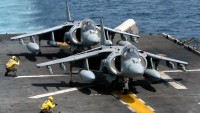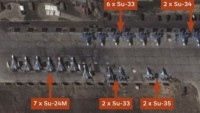Russia says New Tartus Agreement with Syria will Allow it to Control Mediterranean Sea
| Arthur Dominic Villasanta | | Jan 22, 2017 10:36 AM EST |
(Photo : Russian Navy) The Russian support facility at Tartus.
Russia will soon begin work on expanding its small naval facility at the Syrian port city of Tartus along the shores of the Mediterranean Sea into a heavily defended enclave protected by more surface-to-air; anti-ship missiles and aircraft from the Russian Aerospace Forces.
The Syrian and Russian governments signed an agreement on Jan. 18 offering Russia free use of Tartus for 49 years. The term can be automatically extended for further 25-year periods if neither side objects.
Like Us on Facebook
The deal allows Russia to modernize its "Material-Technical Support Point," its technical term for its Tartus facility, so it can host up to 11 Russian Navy ships at a time, including nuclear-powered ones. Russia will also beef-up the air defense and sea defense systems protecting Tartus.
The Soviet Union first signed a deal with Syria to establish the facility in 1983.
Russian media said the agreement "will make it possible for Russia to control the entire Mediterranean region, the Middle East, North Africa and NATO's southern border more confidently."
"The mere fact of the presence of Russian warships and submarines, especially those armed with Kalibr cruise missiles, will make it possible to keep control of the entire region and repel any threats," said Igor Korotchenko, the editor-in-chief of the National Defense journal.
"Naturally, it will be a major factor to deter unfriendly actions against Russia by any regional and international players."
The public relations spin, however, is the Russian facility at Tartus will help "support peace and stability in the region," adding that "it has a defensive character and isn't directed against any other nation."
Tartus is the Russian Navy's only Mediterranean repair and replenishment facility. It can accommodate four medium-sized vessels but only if both of its 100 meter floating piers are operational. It can't host any of the Russian Navy's major warships, however.
Russia has used Tartus to back its campaign in support of Syrian President Bashar Assad against fighters battling to oust him in the Syrian Civil War.
TagsRussia, Tartus, Mediterranean Sea, Syria, Russian Navy
©2015 Chinatopix All rights reserved. Do not reproduce without permission
 US and Coalition Airstrikes against ISIS in Mosul Reach Record Level
US and Coalition Airstrikes against ISIS in Mosul Reach Record Level Obama’s Non-interventionist US Foreign Policy Dies with Aleppo’s Fall
Obama’s Non-interventionist US Foreign Policy Dies with Aleppo’s Fall US Navy and Marines Intensify Airstrikes against ISIS in Libya
US Navy and Marines Intensify Airstrikes against ISIS in Libya Russian Aircraft Carrier Admiral Kuznetsov no Longer Launching Air Strikes after Complete Failure of Landing System
Russian Aircraft Carrier Admiral Kuznetsov no Longer Launching Air Strikes after Complete Failure of Landing System
EDITOR'S PICKS
-

Did the Trump administration just announce plans for a trade war with ‘hostile’ China and Russia?
-

US Senate passes Taiwan travel bill slammed by China
-

As Yan Sihong’s family grieves, here are other Chinese students who went missing abroad. Some have never been found
-

Beijing blasts Western critics who ‘smear China’ with the term sharp power
-

China Envoy Seeks to Defuse Tensions With U.S. as a Trade War Brews
-

Singapore's Deputy PM Provides Bitcoin Vote of Confidence Amid China's Blanket Bans
-

China warns investors over risks in overseas virtual currency trading
-

Chinese government most trustworthy: survey
-

Kashima Antlers On Course For Back-To-Back Titles
MOST POPULAR
LATEST NEWS
Zhou Yongkang: China's Former Security Chief Sentenced to Life in Prison

China's former Chief of the Ministry of Public Security, Zhou Yongkang, has been given a life sentence after he was found guilty of abusing his office, bribery and deliberately ... Full Article
TRENDING STORY

China Pork Prices Expected to Stabilize As The Supplies Recover

Elephone P9000 Smartphone is now on Sale on Amazon India

There's a Big Chance Cliffhangers Won't Still Be Resolved When Grey's Anatomy Season 13 Returns

Supreme Court Ruled on Samsung vs Apple Dispute for Patent Infringement

Microsoft Surface Pro 5 Rumors and Release Date: What is the Latest?










